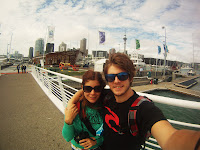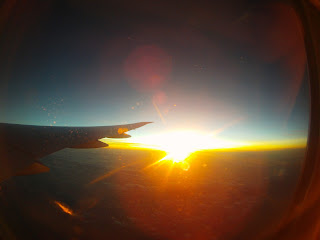 |
Mount Tongariro's head lost in the
clouds on the left, while Ngaurahoe
stands proud to the right.
|
The recent weeks have been blighted with heavy rain and overcast skies, atypical of the summers this country is used to, so when my day off correlated with Amy's, and the promise of clear and fine conditions, we had little hesitation in deciding what we were going to do with ourselves.
Everyone I'd spoken to about the TAC recommended starting as early as possible, so we booked our campsite and shuttle, and made the three hour drive down to Tongariro National Park the evening before, past rolling fairytale hills and the vast blue waters of Lake Taupo. We spent the night at the Discovery Lodge, a site with an uninterrupted view of the massif, and further south to the grand peaks and ski fields of Mount Ruapehu.
 |
| Ngaurahoe's ethereal silhouette looming from the mist as the sun rises. |
 |
Mount Taranaki's summit on the horizon,
a hundred miles away.
|
Before long, the sun had burned through the mist, giving us a completely clear conditions to start the ascent to the crossing itself. The climb up the Devil's Staircase itself was surprisingly easy, with steps built into the face of the scree, and we made it to the Mangateopopo Saddle before 9am. The Saddle sits between the rugged ridges and craters of Mount Tongariro and the perfectly conical textbook volcano of Ngaurahoe. A small sign advised walkers that the most recent major eruption of Ngaurahoe was just forty years ago, and what to do in the hopeless case of an eruption - run, basically, in the opposite direction to flying rocks. Far off in the distance, the snow-capped peak of Taranaki (Mount Egmont) poked out from above the clouds almost a hundred miles away, crystal clear against the blue of the sky.
 |
The magnificent landscape from the summit of Tongariro: Ngaurahoe in
the foreground, with Ruapehu behind.
|
 As we made our way back to the TAC track, the encouragement for an early start became justified: the pathway along the South Crater looked like a column of ants marching across the moonscape. Moving fast to beat the throngs of tourists, we clambered back down to the edge of the Red Crater, an ominous, somehow fearsome feature of deep red rock and dust, with fumeroles steaming from its surface. The landscape looked martian as we made our way around its edge, and down the scree to the equally surreal Emerald Lakes.
As we made our way back to the TAC track, the encouragement for an early start became justified: the pathway along the South Crater looked like a column of ants marching across the moonscape. Moving fast to beat the throngs of tourists, we clambered back down to the edge of the Red Crater, an ominous, somehow fearsome feature of deep red rock and dust, with fumeroles steaming from its surface. The landscape looked martian as we made our way around its edge, and down the scree to the equally surreal Emerald Lakes. |
Amy making her way around
the Emerald Lakes
|

If the Red Crater is the dark, formidable side of this volcano, then the Emerald lakes are at the other end of the spectrum. The three pools of mineral-rich water glow with incandescent colours creating a beautiful other-worldly effect. The rock around them steams with geothermal activity, a reminder that this volcano is very much alive, breathing sulphurous breath from lungs deep within the rock.
By 11:30, we had begun the descent; a long, winding path of countless steps through fragile alpine scrub with beautiful views across to lake Rotoaira and the mighty Lake Taupo. The sacred Maori site of Ketetahi hot springs blasted clouds of steam to our left as we worked our way down to the valley floor, and after a few long hours of trudging through scrub and bush, we made it back to the car park and our shuttle bus tired and happy, completing the Tongariro Alpine Crossing in a respectable 7 and a quarter hours!
The day was truly incredible, and Tongariro is a very special place. Be warned though, we saw it in the best conditions possible but they can soon turn. We saw far too many people up there in trainers, shorts and t-shirt, and some without food or water. At almost 2000m high, the crossing is definitely alpine and should not be taken lightly, as weather conditions can change at a moment's notice. Make sure you're prepared for anything!
We ended the day with a well-earned meal beside Lake Taupo: an amazing rack of lamb complemented by the stunning view of our day's conquests on the far shore.
Perfect.




















